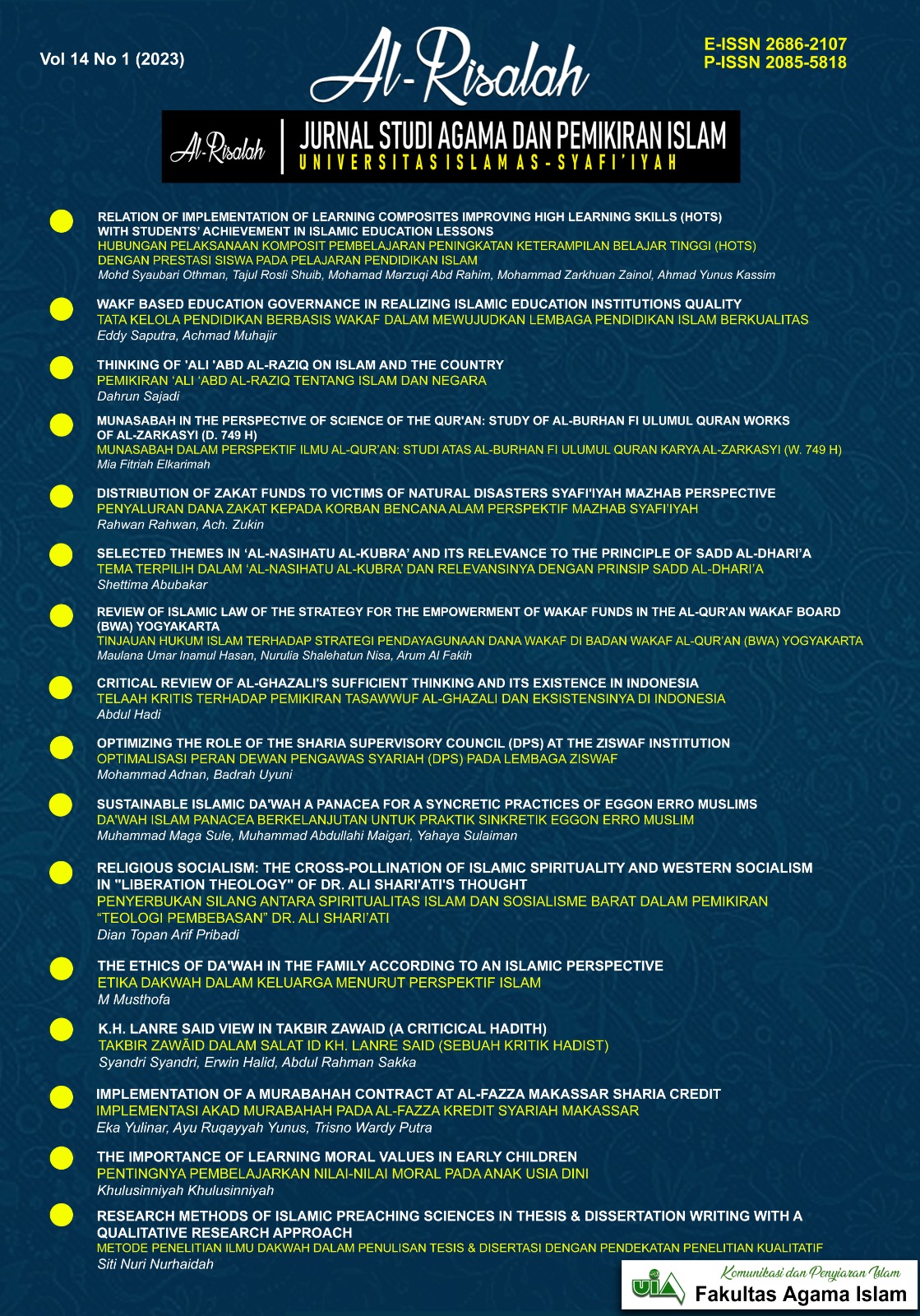DISTRIBUTION OF ZAKAT FUNDS TO VICTIMS OF NATURAL DISASTERS SYAFI'IYAH MAZHAB PERSPECTIVE
PENYALURAN DANA ZAKAT KEPADA KORBAN BENCANA ALAM PERSPEKTIF MAZHAB SYAFI’IYAH
Abstract
This paper focuses on discussing zakat assets. The discussion taken is the review of the Syafi'iyah scholars regarding the legal status of distributing zakat assets to disaster victims and the legal status of using zakat assets for home renovation and business capital. Discussing the problem of distributing zakat to disaster victims will not be separated from the theory of zakat itself. Because to know the legal status, we also have to know which category the mustahik fall into, which are the victims of the disaster, they are entitled to receive zakat assets or not. Not many classic books from the Shafi'i Imams discuss the distribution of zakat assets for disaster victims, but several books discuss this matter. Based on the theory and data obtained, disaster victims are categorized into three mustahik: the indigent, the poor, and the ghorim. However, after being analyzed, what is more, realistic is to include them in the poor category because their situation at that time was very in line with the definition of poor. It indicates that the legal status of the zakat is valid. The second concerns the legal status of using zakat assets for home renovation and business capital. Based on the theory and data collected, the legal use is considered valid because it is under the purpose of zakat, namely eliminating poverty; even zakat funds are very beneficial for the survival of mustahik, not only in the short term and long term.
Tulisan ini fokus membahas harta zakat. Pembahasan yang dilakukan adalah kajian ulama Syafi'iyah mengenai status hukum penyaluran harta zakat korban bencana dan status hukum pemanfaatan harta zakat untuk renovasi rumah dan modal usaha. Membahas masalah pendistribusian zakat kepada korban bencana tidak akan lepas dari teori zakat itu sendiri. Karena untuk mengetahui status hukumnya, kita juga harus mengetahui golongan mustahik yang mana yang menjadi korban bencana, apakah mereka berhak menerima harta zakat atau tidak. Tidak banyak kitab klasik Imam Syafi'i yang membahas tentang pembagian harta zakat untuk korban bencana, namun beberapa kitab membahas hal ini. Berdasarkan teori dan data yang diperoleh, korban bencana dikategorikan menjadi tiga mustahik: fakir, miskin, dan ghorim. Namun setelah dianalisis, yang lebih realistis adalah memasukkan mereka ke dalam kategori miskin karena keadaan mereka saat itu sangat sesuai dengan definisi miskin. Hal ini menunjukkan bahwa status hukum zakat itu sah. Kedua menyangkut status hukum penggunaan harta zakat untuk renovasi rumah dan modal usaha. Berdasarkan teori dan data yang terkumpul, penggunaan hukum dianggap sah karena sesuai dengan tujuan zakat, yaitu menghilangkan kemiskinan; bahkan dana zakat sangat bermanfaat bagi kelangsungan hidup mustahik, tidak hanya dalam jangka pendek maupun jangka panjang.
Copyright (c) 2022 Al-Risalah : Jurnal Studi Agama dan Pemikiran Islam

This work is licensed under a Creative Commons Attribution 4.0 International License.
This work is licensed under a Lisensi Creative Commons Atribusi 4.0 Internasional.
Authors who publish with this journal agree to the following terms:
- Authors retain copyright and grant the journal right of first publication with the work simultaneously licensed under a Creative Commons Attribution License that allows others to share the work with an acknowledgement of the work's authorship and initial publication in this journal.
- Authors are able to enter into separate, additional contractual arrangements for the non-exclusive distribution of the journal's published version of the work (e.g., post it to an institutional repository or publish it in a book), with an acknowledgement of its initial publication in this journal.
- Authors are permitted and encouraged to post their work online (e.g., in institutional repositories or on their website) prior to and during the submission process, as it can lead to productive exchanges, as well as earlier and greater citation of published work (See The Effect of Open Access).















